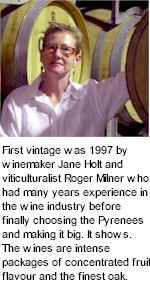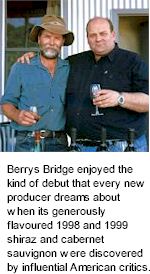


They selected a site just outside of the main nexus of Pyrenees estates to plant vines. Ironically settling on the very terrain operated a century earlier by a Mr Berry who had also planted Shiraz. George Berry started his vineyard and orchard in 1862 on the banks of Carapooee Creek. Whilst some rootstock 110 to 140 years old can still be found, today's Berry Bridge are the fruit of plantings by Jane Holt and Roger Milner. Milner developed his passion for viticulture after several vintages at Chateau Reynella in the 1970s. He joined forces with Holt BAppSc(WineSc) & AssocDegAppSc(Wine-growing), and happily took on the challenge of re-developing the site.

Berrys Bridge has a very limited production of three super premium Australian wines, Shiraz, Cabernet Sauvignon, and in some years Merlot. Vines were first planted in 1990, but the history of the site dates back to 1894 when a Mr Berry was growing grapes and making wine - "hermitage (shiraz) ... second to none" - from a 30 year-old vineyard on almost the same spot. The 6.5 hectare vineyard and winery is in the northern foothills of the Australian Pyrenees Ranges in the state of Victoria.
Hand crafted, single vineyard wines are dry grown and vinified on site by the resident viticulturalist and resident winemaker. Hand picked fruit receives small batch open fermentation, is hand plunged and basket pressed. Wines are matured in oak barriques and are bottled on site, unfiltered, before a temperature controlled bottle storage.
Rich red clay soils, warm summer days and cool nights provide lush ripe berries with intense colour, concentrated flavour and complex tannin structure. The Berrys Bridge Vineyard is favoured with winter/spring rainfall and relatively dry summers. Good canopy management generally minimises disease impact in this mild climate, and the ecologically friendly option is always chosen when selecting vineyard inputs. Many species of insect-eating birds love the habitat contributing to a healthy and diverse environment.

"I stumbled across this box marked Berrys Bridge. "Whassthis, then?" I muttered to myself. It was a new shiraz from the Pyrenees wine region, in western Victoria. Berrys who? Never 'eard of 'em. A couple of weeks later and I'm staring into a glass of pretty impressive purple liquid, thinking to myself, "Gee, this is good." It turns out that there is a 1998 cabernet sauvignon as well as a 1998 shiraz on offer from Berrys Bridge, both about $28 a bottle. And now, having tasted them in all their youthful, vibrant, gutsy glory (the wines nudge 15.5 per cent alcohol), I'm keen to find out more!" -Max Allen
"Situated on the bank of Carapooee Creek is the loveliest orchard imaginable having been there for 32 years. Entering through a wicket gate in a picket fence the flower garden is a picture and the odour of roses delicious. In the orchard the vines call for special notice, consisting of 2000 vines in full bearing, varieties being - Gordo Blanco; Muscat Alex; Raisin de Dame; Black Cluster; White Muscat; Black Muscat; Black St. Peter; Golden Cluster' Black Hermitage and Sweet Water. The orchard and garden are in ship shape condition. Mr. Berry makes wine - Hermitage, he finds a ready sale for all his fruit and vegetables and visits St Arnaud three times a week in the fruit season. He relies wholly on his garden and orchard for any return. There may be larger orchards in Kara Kara but not another one to compete with Mr. Berry for a natty completeness of style and general all round tidiness!" -Travelling Reporter, Mercury 5 Dec/1894
"Berrys Bridge enjoyed the kind of debut that every new producer dreams about when its generously flavoured 1998 and 1999 shiraz and cabernet sauvignon were "discovered" by US wine buyers and critics. First vintage was 1997 by winemaker Jane Holt and viticulturalist Roger Milner had many years experience in the wine industry before finally choosing the Pyrenees and making it big. It shows. The wines (there is a merlot too) are intense packages of concentrated fruit flavour distinguished by fine oak!" -The Age
